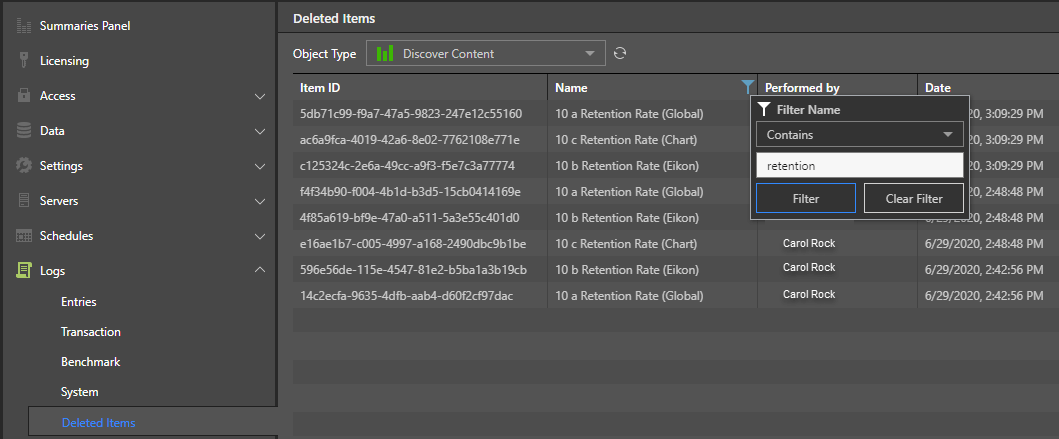2020.10 is the latest release from Pyramid Analytics. It extends the functionality introduced in our major 2020 release. This is one in a series of posts that highlights some of the major new features.
Pyramid’s Audit Trail provides users with a framework to track all changes made to key objects throughout the system—providing administrators with a clear view and history of when an object was created, changed, or deleted—by date and by user. The audit logging is performed for content items and non-content items alike. Content items include data models, reports, dashboards, formulas, images, publications, and folders. Non-content items include users, roles, user profiles, tenants, schedules, data sources, databases, server instances, mobile devices, machine learning models, AI and ML environments, custom fonts, custom maps, and themes.
The problem
Administrators need to be able to track who made changes to content items and when they were performed. Similarly, all administrative functions performed on non-content items need to be tracked. Some BI tool vendors (such as Power BI and Tableau), encourage users to utilize desktop tools, and consequently use local definitions of data and artifacts—eliminating the opportunity to track the lifecycle of objects in a broadly deployed and managed platform. Other server-based solutions work off a siloed project model or lack the infrastructure to track and annotate events for the artifacts in the system. This makes it very difficult for admins to monitor and manage.
The solution
Pyramid addresses the auditing function with a powerful approach based on its centralized server-based architecture, sharable data models, and centralized business logic and reporting. Pyramid’s Audit Trail Framework records all activities (create, modify, and delete) on all content and non-content items, generating a system-wide audit log, listing dates, times, users, and actions performed for all items. An easily accessible and comprehensive audit trail report provides total transparency of maintenance tasks performed for 21 key object types. Administrators can access a historical view of all deleted items per object type.
Business case
John is a BI administrator at PQR Retail Inc. They are using Pyramid to deliver analytics on their ERP system and John would like to track activities. Specifically, he would like to investigate who has made recent changes to the admin role, as certain users have not had access to data that they should have been able to access. In addition, John would like to view an audit log of recent changes made to a report, and a list of reports that have recently been purged.
Audit trail of non-content items
John accesses the finance role from the admin console. He clicks on the audit trail button for the finance role and views all activity performed on the role and notices that Mike Anderson has indeed made some recent changes. John will have a conversation with Mike to understand why he made changes.


Audit trail for content items
John now wants to review changes that were made to the calculation formula for the Budget Differential, as the formula no longer works as it used to. He clicks on the audit trail button from the Explorer folder and views the audit log.

John see that Jan Mulder has updated the calculation. Jan will have to explain his calculation change.
Audit for all deleted items per content type
John would now like to view all the deleted Discover items relating to retention rates, as dashboards containing these reports are no longer displaying results. The admin console provides administrators the ability to view all deleted items for any of the key object types from both content and non-content items. In this example, by selecting the “Discover Content” object type, John can view all Discover items that have been purged (not soft-deleted). In order to further filter the results, John uses the filter on the item name to narrow down the list of items displayed.

The mystery has been solved—Carol has deleted the reports, so John will discuss this further with her.
Summary
Pyramid’s Audit Trail tracks all changes made to key objects throughout the system for both content and non-content items—providing a clear view of when an object was created, changed, or deleted.
Some BI tools encourage users to utilize desktop tools, eliminating the opportunity to track the lifecycle of objects in a broadly deployed and managed platform. Other server-based solutions work off a siloed project model or lack the infrastructure to track and annotate events for the artifacts in the system. Both make it very difficult (maybe impossible) for admins to monitor and manage.
Pyramid addresses the auditing function with a powerful approach based on its centralized server-based architecture, sharable data models, and centralized business logic and reporting. The Audit Trail Framework records all activities, generating a system-wide audit log listing dates, times, users, and actions performed for all items. An easily accessible and comprehensive audit trail report provides total transparency of maintenance tasks performed. Administrators can also access a historical view of all deleted items per object type.
2020.10 new feature series:
Pyramid 2020.10 is chock full of powerful features like the audit log capabilities described above. For more detail about some of the other new headline features contained in the 2020.10 release, please see these additional write-ups:
- Post 1 – Calendar Slicer: The smart Calendar Slicer in Pyramid is designed to make date-time operations fast and simple for both novice and advanced users alike. It is especially useful when more date-time structures in the original data source do not exist and users do not want to use complex formulas to filter data with dates.
- Post 2 – Ragged Queries: The ragged query feature in Pyramid helps users create highly complex views of data, allowing them to easily “laser” out content items they do not want to see in a report—effectively building an “asymmetric” query.
- Post 3 – Self-Building Data Catalogs: Pyramid provides users with a self-building and self-maintaining documentation mechanism for data and analytics. The ‘Data Catalog’ helps analysts and administrators to find the data or analytical assets that they need.
- Post 4 – Data Catalog Toolkit: Learn about Pyramid’s Structure Analyzer, Data Source Changer and Lineage tool, all of which provides a graphical, intuitive set of mechanisms to all the elements in the system, fully exploiting the power of centralized data and asset cataloging.
- Post 5 – Flow Grids and Flow Charts: The flow grid and flow chart tools in Pyramid are designed to dramatically extend the grid and chart capability for publications.
- Post 6 – Present Lite: The new Present Lite tool is designed to create quick and easy dashboards for non-technical users. Users will experience a simplified UI with fewer advanced features, and they will get all the essential tools required for creating self-service, self-built dashboards.
- Post 8 – Datavard Glue: Pyramid now integrates seamlessly with Datavard’s “Glue” – a third-party tool that allows users to trigger and extract raw SAP ERP data. The data can then be ingested into Pyramid by end users for further analysis and reporting.
- Post 9 – Content Migration: Pyramid users can easily migrate content from one Pyramid instance to another with an easy, intuitive wizard assisting them through the process. This facilitates re-use of content items with efficient processes to ensure governance and security.
















